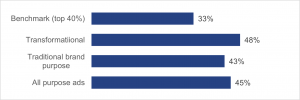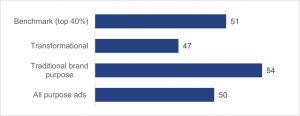New GfK study shows purpose-driven ads fall short in gaining, holding attention -- pointing to need for new approaches
Collaboration with Goodvertising Agency reveals value of “transformational” campaigns – making consumers heroes
NEW YORK, NEW YORK, UNITED STATES, June 15, 2022 /EINPresswire.com/ -- At a time when so many companies are rushing to claim sustainability, social justice, and other causes as core to their brands, discussions about the effectiveness of these campaigns have been largely absent. With millions of dollars being spent to define and promote the “purposes” of brands, what are the real outcomes?The first findings from The Purpose Impact Monitor – a new, ongoing study developed by GfK in association with Goodvertising Agency – show that brand purpose ads generally underperform mainstream ads* when it comes to grabbing and holding viewers’ attention. (See Table 1.)
Download a booklet with more results from this study
While three-quarters of mainstream* ads were able to capture attention, the proportion dropped to two-thirds for purpose ads. And while more than half of mainstream ads kept viewers engaged, the figure was 11 points lower for purpose creatives.
* Mainstream ads = Top 40% of creatives in hook/hold performance
The study also compared two types of purpose creatives –
• traditional purpose ads, in which the brand presents itself as the hero, and
• “transformational” purpose ads, which put the spotlight on what consumers can and do accomplish.
The latter category was identified and named by Thomas Kolster of Goodvertising Agency, a leader in innovative approaches to purpose-driven marketing, in his book The Hero Trap.
The new research showed that transformational ads performed best when it came to delivering a clear message. (See Table 2.) Nearly half (48%) of transformational ad viewers reported that the message was clear, compared to just one-third (33%) for mainstream ads and 43% for traditional purpose spots.
When it came to branding metrics – such as recall – the purpose ads overall were on par with mainstream ads. (See Table 3.) But traditional purpose ads bested transformational ones significantly in this area – most likely because the traditional ads are more aggressive about promoting the brands themselves within the spots. Transformational ads, by definition, downplay the brand and make consumers the heroes, which might cause a deficit when looking at common brand markers.
One telling contrast can be seen in purpose spots from Dove (“Reverse Selfie”) and Chipotle (“Can a Burrito Change the World?”). The former takes a transformational approach, showing what it takes to push back on the pressure girls feel to look perfect on social media, while Chipotle’s is a classic purpose spot focusing on the product itself. While diagnostics for the two were similar in some ways, Dove scored significantly higher on agreement with key attitudinal statements such as “inspires me to be part of the change.”
“I’ve been in the purpose space for more than a decade,” said Kolster, “and there’s no doubt it is increasingly difficult to cut through with a classic purpose angle – ‘We care!’ It’s time brands stop pitching themselves as the heroes and instead turn people into the heroes. When brands help people become healthier or greener, consumers can feel the difference; it is not just another grandiose brand claim.”
“Purpose marketing represents billion-dollar investment for brands — so these campaigns need to meet high standards,” observed Eric Villain, Managing Director Marketing Effectiveness GfK North America. “While branding cues are somewhat more frequent in traditional purpose ads, we found that those creatives underperform on key metrics, suggesting that new approaches may be needed. Our hypothesis is that the very definition of a transformative approach may take viewers more time and viewings to understand how they, along with the brand, can be part of the story. Because viewers are more accustomed to messages in traditional purpose ads, those are easier to grasp.”
Using its proprietary Ad Fit Optimizer (AFO) ad testing solution, GfK surveyed 2,408 respondents and measured 20 advertisements, divided equally between traditional purpose branding and transformational branding ads. Field dates were March 28th – 31st 2022.
Goodvertising Agency – catalysts for positive change since 2009.
Since 2010, Goodvertising Agency have been pioneers in showcasing a different way forward, sparking a global movement for meaningful growth. Founded by global thought-leader and purpose-pioneer Thomas Kolster, Goodvertising is a worldwide player working across the marketing and advertising ecosystem – from brands, agencies, media to industry bodies. Its proprietary strategic tools for brand transformation are globally used, and its change programs have inspired and shifted minds and behaviors in more than 70 markets. Goodvertising‘s creative lab keeps challenging the status quo on a search for new ways to create impact.
For more information, please visit www.goodvertisingagency.com or follow Thomas Kolster on Twitter www.twitter.com/thomaskolster
GfK. Growth from Knowledge.
For over 85 years, we have earned the trust of our clients around the world by supporting them in business-critical decision-making processes around consumers, markets, brands, and media. Our reliable data and insights, together with advanced AI capabilities, have revolutionized access to real-time, actionable recommendations that drive marketing, sales and organizational effectiveness of our clients and partners. That’s how we promise and deliver Growth from Knowledge.
For more information, please visit www.gfk.com/en-us or follow GfK on Twitter www.twitter.com/GfK.
David Stanton
GfK
+1 908-875-9844
email us here
Legal Disclaimer:
EIN Presswire provides this news content "as is" without warranty of any kind. We do not accept any responsibility or liability for the accuracy, content, images, videos, licenses, completeness, legality, or reliability of the information contained in this article. If you have any complaints or copyright issues related to this article, kindly contact the author above.



